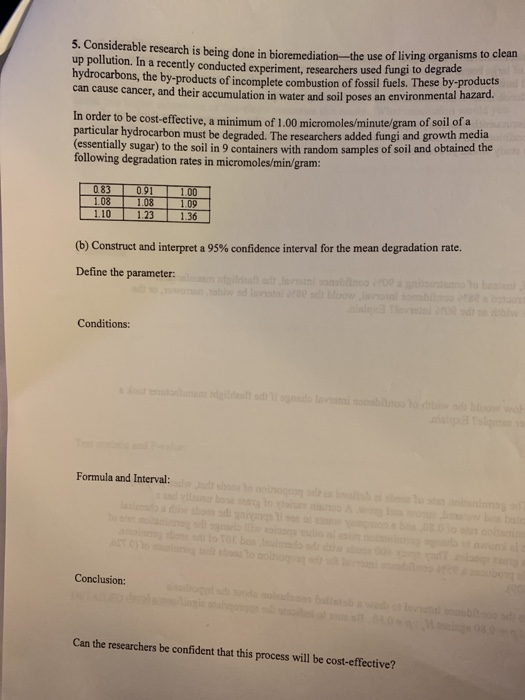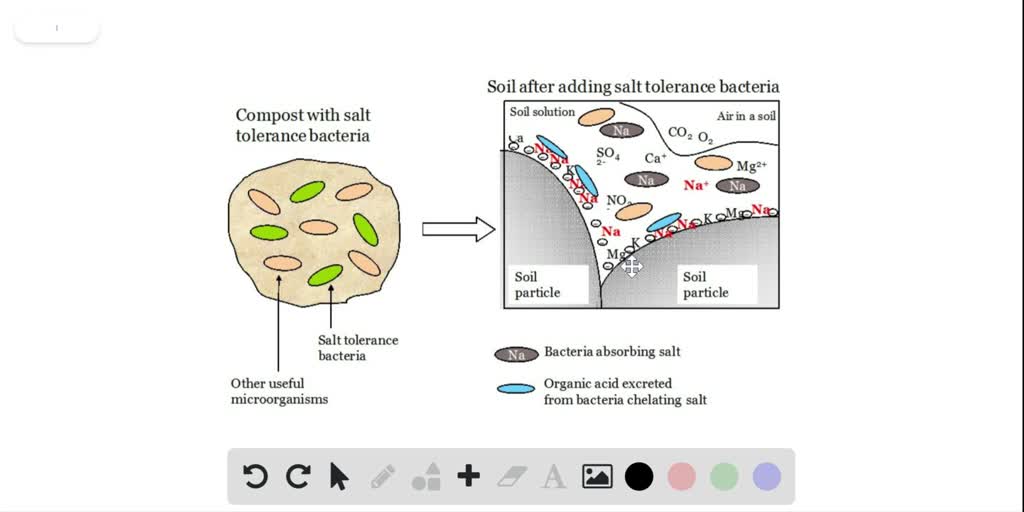5 there are several. Two common forms of this method include biostimulation and bioaugmentation.

Solved Considerable Research Is Being Done In Bioremediation Chegg Com
Cometabolic bioremediation is extremely under appreciated as a bioremediation strategy though it has been used for an extremely wide variety of contaminants in different environ- mentswithdifferentcosubstratesmuchmoreresearchneedstobedoneonmodelinglifecycle costs of various remediation strategies including treatment trains and grading into.

. Demonstration of contaminants loss from contaminated sites demonstration based on laboratory analyses that microorganisms isolated from contaminated sites have the innate potentials to biodegrade or. It has far-reaching applications in cleaning up contaminated soils industrial wastewater groundwater mines pesticide accumulated sites and fly ash disposal sites. To fully understand bioremediation we must discuss the term biodegradation.
Suitability for bioremediation Bioremediation is not a new concept and is being increasingly used as a relatively economical. This is a corresponding 5 6 10 and 29 higher efficiency as observed unimmobilized consortium. The use of microorganisms in bioremediation is not limited to bacteria.
According to the United States National Research Council US NRC there are three criteria that must be met in intrinsic bioremediation and these include. Inputs Fates and Effects Academy ess 1983. Subsidize research on the topic5 Considerable basic knowledge about factors that affectnatural biodeg-radation about the kinds of hydrocarbons capable of being degraded and about the species and distribu-INatio Washington DC.
Bioremediation has technical and cost advantages although it can often take more time to carry out than traditional methods. In a recently conducted experiment researchers used fungi to degrade hydrocarbons the by-products of incomplete combustion of fossil fuels. There are two types of bioremediationex situ remove and treat and in situ treat in place and can be performed on soil or underground water.
Bioremediation is not a new technology. The in-situ bioremediation can be done in two ways depending on possible human involvement in its implementation. Bioremediation is the transformation or degradation of contaminants into non-hazardous or less hazardous chemicals4.
The main goal of this project is to contribute to assessment and management of soil bioremediation systems to increase the rate of treatment and therefore decrease the time required for achieving required treatment levels for unsaturated soil. They explore how in situ bioremediation works how it has developed since its first commercial use in 1972 and what research and education efforts are recommended for the future. B in-situ bioremediation by applying engineering measures In this method microbial processes are accelerated by applying specific engineering procedures.
These by-products can cause cancer and their accumulation in. Bacteria are generally used for bioremediation but fungi algae and plants have also been used. One can anticipate based on the results of the Alaska Project considerable variation in the degree of bioremediation.
Considerable research is being done in bioremediation - the use of living organisms to clean up pollution. Bioremediation experts representing academic research field practice regulation and industry provide accessible information and case examples. Biodegradation is a natural process by which microbes alter and break down oil into other substances.
It is a type of waste management technique which involves the use of organisms to remove or utilize the pollutants from a polluted area. Bioremediation of many such recalcitrant compounds has been successfully field tested see the case examples in Boxes 4-1 and 4-3 in Chapter 4. 4 attention is now focused on insitu technologies that include bioremediation intrinsic contaminant degradation and contaminant containment and treatment with insitu permeable chemical barriers.
Several methods were used to collect and analyze data including content analysis of transcripts of face-to-face personal interviews factor analysis of subjective perspectives using Q methodology and statistical analysis of results from a. The rate-limiting material often is the primary electron donor or electron acceptor. Bioremediation is an option that offers the possibility to destroy or render harmless various contaminants using natural biological activity.
Early remedial approaches such as excavation and groundwater pumping and treatment have proved inadequate to address the problem. There are several remedies where contaminated water or solid is purified by chemical treatment incineration and burial in a landfill. Biodegradation rate models are most easily combined with flow models when one rate-limiting material can be identified.
National Research COunCil oil in the Sea. There are three types of bioremediation strategies involving microorganisms. Recently research has intensified on bioremediation of less easily degraded compounds such as chlorinated solvents pesticides and polychlorinated biphenyls PCBs.
Bioremediation A very interesting area of research being done at a large university is in bioremediation - the use of living organisms to clean up pollution. For example the biodegradation rate of petroleum hydrocarbons often can be modeled with dissolved oxygen as the rate-limiting substance. In a recently done experiment researchers used filamentous fungi to degrade polycyclic aromatic hydrocarbons - the byproducts of incomplete combustion of fossil fuels.
The resulting products can be carbon dioxide water and simpler compounds that do not affect the environment. A challenge to the Agency lies in taking these results from Prince William Sound and establishing a basis for dealing with future oil spills wherein bioremediation using fertilizers would be the method of choice. Statistics and Probability questions and answers.
This guideline applies only to the ex situ treatment of soils. Bioremediation is the optimization of biodegradation. After 15 days of a laboratory scale bioremediation set up agro-waste immobilized consortium showed a reduction in phenol 99 BOD 5 96 COD 92 oil and grease 93.
Bioremediation can be tailored to the needs of the polluted site in question and the specific microbes needed to break down the pollutant are encouraged by selecting the limiting factor needed to promote their growth. As such it uses relatively low-cost low-technology techniques which generally have a high public acceptance and can often be carried out on site. Bioremediation is not just limited to cleaning oil spills.
Bioremediation is a biotechnical process which abates or cleans up contamination. 1 Natural attenuation In some cases natural populations adapt to the contaminant conditions and are able to convert the contaminants to non-hazardous. Environmental biotechnology related research is expected to increase by 147M over current funding of 686M.
The White House Presidential Initiative for Biotechnology for Fiscal Year 93 represents an opportunity for the development of a basic and applied strategic research plan for bioremediation 8.
Considerable Research Is Being Done In Bioremediation The Use Of Living Organisms To Clean Up Pollution In A Recent

Solved 18 Considerable Research Is Being Done In Chegg Com

Solved 2 Considerable Research Is Being Done In Chegg Com

Solved Considerable Research Is Being Done In Chegg Com

Solved 5 Considerable Research Is Being Done In Chegg Com

Solved 5 Considerable Research Is Being Done In Chegg Com
Solved Considerable Research Is Being Done In Bioremediationthe Use Of Living Organisms To Clean Up Pollution In A Recently Conducted Experiment Course Hero

Solved Considerable Research Is Being Done In Bioremediation The Use Of Living Organisms To Clean Up Pollution In A Recently Conducted Experiment Researchers Used Fungi To Degrade Hydrocarbons The By Products Of Incomplete
0 comments
Post a Comment